By Wallace Alfred Wyss
Photos by John Huggins
Long ago, you could go to an Italian carrozzeria and order custom-made bodywork for your Chrysler, or Cadillac or whatever and pay a few thousand bucks and have a car that looked like a million bucks.
There were plenty of workmen and in the early ‘50s, and many factories were still in ruins. Italy was still on the rebound from the war.
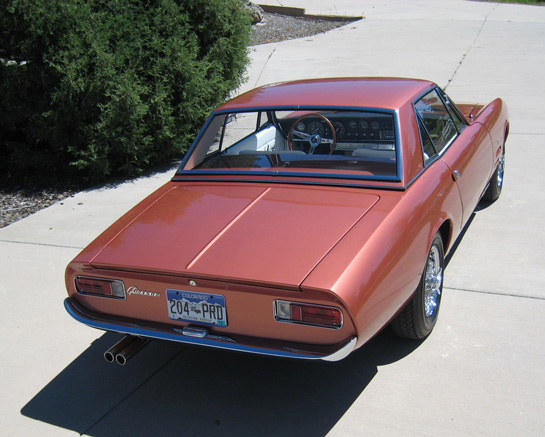
The hardtop takes two men to lift it onto the car. When it is on, the convertible top is folded beneath. If you ever look for a Ghia 450/SS be sure to bargain for the inclusion of the hardtop--it alone is worth $15,000!
By the mid-60s prices of custom bodywork were going up but there were still several automakers ordering bodywork in Italy such as Aston Martin from Touring and Zagato, Porsche from Zagato, BMW from Bertone, and even the Americans, Cadillac for instance having a Brougham built there and Chrysler a special Imperial.
Meanwhile back in Hollywood there was a music producer named Burt Sugarman who happened to read Road & Track. One day on the cover there was a svelte sports car, a fastback Fiat with a six cylinder and one-off coachwork by Ghia. Burt fell in love with it.
But he wasn’t in love with the Fiat chassis and driveline. He liked American V8s. and at the time Chrysler’s 273 cu. in. V8 was the new hot ticket in town, powering the growling Barracuda S, so he made arrangements to buy that engine and transmission and have it installed in a chassis in Italy.
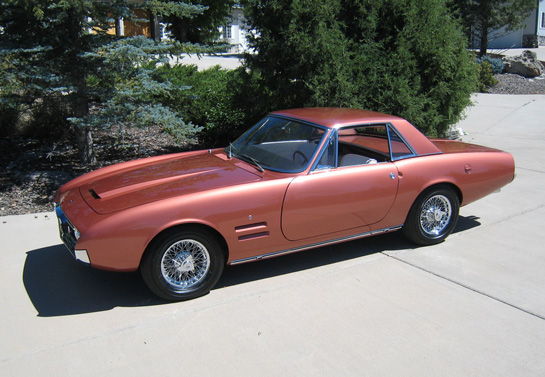
The unadorned body sides were a Giugiaro trademark at the time, usually with an interesting engine side vent.
For bodywork he chose to have instead of a coupe a roadster version of the car he had fallen in love with, but with a lift-off hardtop in addition to the soft top.
The car made its debut at the 1966 Turin show. Giorgetto Giugiaro, the young and capable head of Ghia design, designed the car and it was an excellent example of his talent . Close to the same time he also did the Maserati Ghibli coupe and spyder , the Iso Grifo and several other delectable GT cars.
Alejandro de Tomaso owned Ghia at the time and you might say he bought the firm during its downhill slide, downward from the glory it had won years earlier. Some who don’t like DeTomaso would say the wily Argentinean ex-racer he ruined it but at least Ford in the U.S. was able to buy him out and use the name Ghia for at least a couple decades. It was Ford who finally shuttered the place and killed off the name.
Back to the car. It used longitudinal steel frame members with some reports saying it had a semi-monocoque body. Brakes were discs in front and drums in the rear.
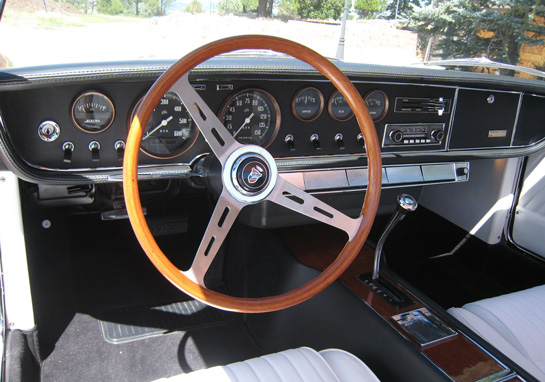
The dashboard looks similar to the Ghibli, also designed by Giugiaro. The gauges are informative but not quite the comprehensive display of the Ghibli. Unlabeled toggle switches look boy racer. The under the dash air conditioner was state of the art for the time and the wood-rimmed steering wheel was exotic for Americans.
The interior was Giugiaro’s simple Ghibli style—a row of gauges, this time set into a slab of timber. The odd thing was to see the automatic shift quadrant of the TorqueFlyte 3-speed automatic—it just looked too American a feature to be seen in an Italian car.
The seats had vertically pleated cushions and were leather covered.
Sugarman priced the car at $11,000 (other sources say $13,000)—probably too high as no American car at the time was priced that high (in 1969 the Lincoln Continental Mk. III was $10,000 and that took some reaching). It was also about 40% more than a Cobra in small block form in ’65 so really he was asking a lot for a car that was too heavy with its steel body to be raceable. But it was still priced under a Ferrari and under a Maserati and everyone knew it would be dirt cheap to service.
The car was only in production for two years–1966 and 1967. After that new safety laws would have required too many changes in the bumpers and other features to make it worth up-dating the car to meet the ever-changing American laws.
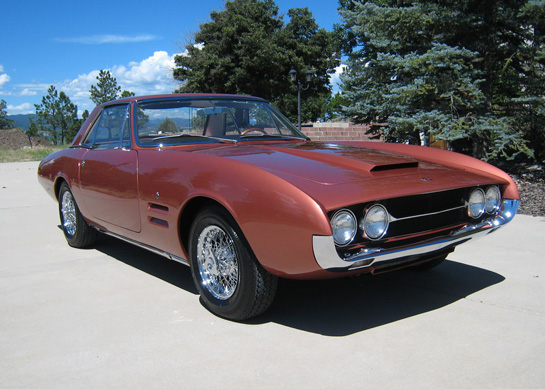
The Ghia SS was finished inside and out with great quality, not a ‘bargain finish’ like the Pantera and others.
The Ghia would have looked really rare if it wasn’t for the fact that later on that nasty old Ford Motor Company copied its nose style to a “T” on the Torino so the result is the car looks rare and exotic from the side and back but like yer average Ford Torino from the front.
The crowning touch was the Borrani wire wheels, in chrome. They really stood out against the rounded smooth sides of the car.
One would’ve thought this car would be all the rage in Hollywood, as the Dual Ghia was a few years earlier…another built-by-Ghia car with American chassis and Chrysler engine. But times had changed, by the time the Ghia 450/SS arrived, there were lots more choices from America, England, Germany and Italy. And the fact that it wasn’t really fast didn’t help either.
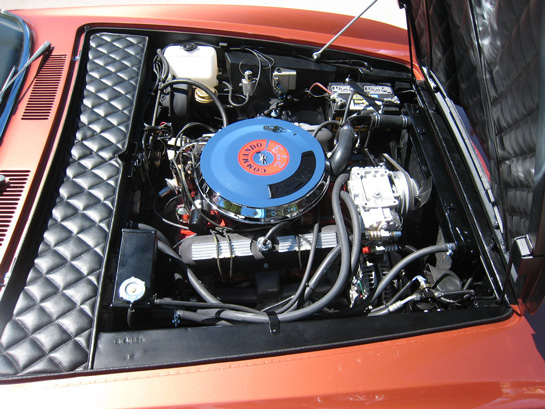
The engine was a Plymouth Barracuda Formula S engine. It was perhaps competitive with the Cobra's 289 but the Ghia had a heavy all steel body where the 289 Cobra had a eggshell thin aluminum body. Quilted sound deadening also appears on cars like the Bizzarini.
I sort of remember Road & Track not liking the handling or braking. They were a bit hard on small automakers but not as hard as Sports Car Graphic which delighted in showing motor drive shot pictures of the DeTomaso Mangusta (also built by Ghia) spinning out of control because it was so tail happy.
Only 52 Ghia 450/SS cars were made. They should sell for over $150,000 when you consider the hand work that went into them but because they come up so rarely for auction, the potential buyers are mystified as to what it is and the last one to go through an auction fetched under $85,000. One also sold at a Barrett Jackson auction in 2009 for $181,500. but that may have been because of its superb condition, having been treated to new paint, new mechanicals, a complete new interior, a refreshing of all the rubber and brightwork, a rebuild of all five Borrani wheels, new brakes, new exhaust, new handmade top, a complete trunk restoration, and a new wiring harness.
I bought one once, from a movie editor. For that purchase took the Type TNP approach, which is short for “Take No Prisoners.” The lady had advertised it but when I called her on a Monday, she said “I am busy editing a movie, I won’t have time until Saturday morning.”
So I called the client in New York, told him to send me a check on what he thought it was worth without seeing it and when I got the check on Wednesday I took it over her house that night with a tow truck following (that because, many times when I bought rare cars, they hadn’t been run for years, weren’t licensed, etc.). She answered the door in a huff, saying “I said I wasn’t seeing anybody about the car until Saturday.” I said “I’m here now with the cashier’s check and the tow truck” and I wrested it away without fisticuffs being necessary.
I don’t remember driving it but know I did drive one at one time or another. It was not memorable, being too heavy to be driven with aplomb, or is it brio?
All I know is, that if it hadn’t had that quad headlamp nose I would have liked it more. In the same general category (Italian body, American V8 engine, I like the Italia by Intermeccanica much more though I know that model has major front end suspension design problems).
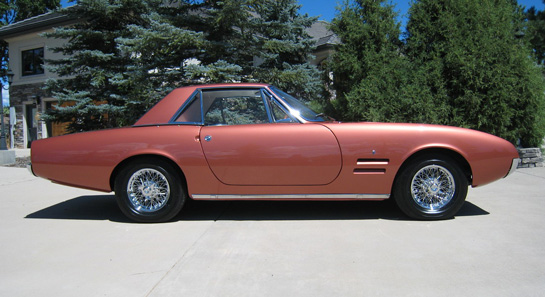
This example is finished in Turbine Bronze, also used by Ghia on the Chrysler Turbine Cars from 1964, which were also built at Ghia.
And what happened to Burt Sugarman? He went on from producing a TV show called the Midnight Special to producing such movies as Kiss Me Goodbye, Extremities and Children of a Lesser God. I couldn’t find references to his current work. I know he was a helluva car collector with Duesenbergs, and a maroon Rolls Royce James Young bodied PV with a big rose painted on the rear deck (Rosebud?).
Other Sixties sports car producers making Italo-American hybrids (Frank Reisner with Intermeccanica, Milt Brown with Apollo, etc.) got more ink and Sugarman faded out of the picture in the car world but we have to say, in reterospect that we appreciate his eye and thank him for rescuing a Giugaro design and making it available to us style-starved Yanks….
The Ghia 450SS pictured in this article is currently for sale. Contact pete@velocetoday.com for details.
The Author: Wyss is putting the finishing touches on his suspense thriller about a classic car-buying private detective, which will include some of his real life adventures.
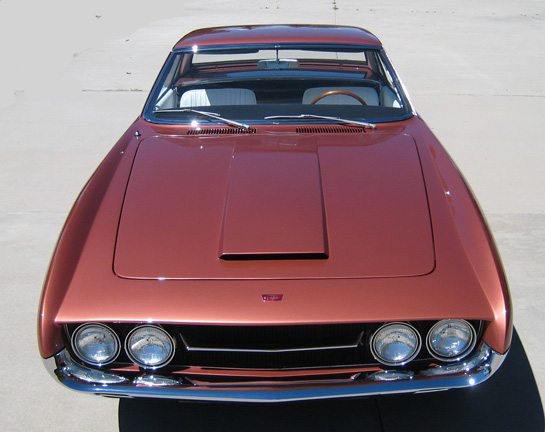
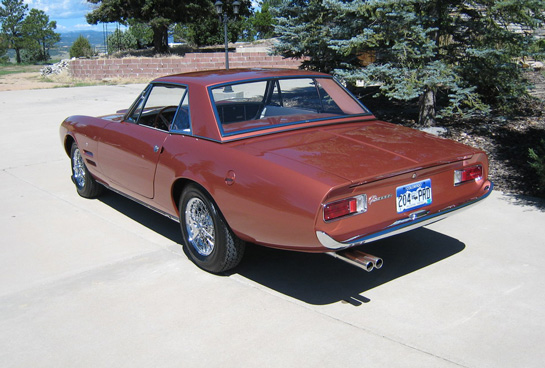
I had the opportunity to drive both the ’66 Formula S Barracuda, as my Dad had one, and the 450 SS, as a local movie producer had one, and he asked me to do a tune up on the 273. The 273 engines were solid lifter, and had dual point ignitions.
How all this came together is another story involving my high school girlfriend, her director father, and his Lancia Flaminia Cabriolet.
Though I was young and in my senior year of high school, I still remember the cars well. The Barracuda was lighter, handled better. Less body roll, and since Dad’s car had a 4 speed, it certainly was quicker. The power steering had no feel at all, and was very light. That said, it was probably the best handling V8 compact at that time, in part due to the Goodyear “Blue Streak” tires, and my installation of Koni shocks.
The 450 had the same sound, more body roll, and didn’t really like being tossed around. It had the same light, lifeless, somewhat slow steering, and was sprung softer. There was also some chassis flex and cowl shake. On the plus side, the seats were very comfortable, as the back rest had a break in it to support the shoulders. I also remember lovely paint, and a very careful fit and finish when compared to the Barracuda. Italian cars were filled with jewel like parts, and the Ghia a full compliment of tastefully applied chrome and polished stainless. It was then, as it is now, extraordinarily beautiful, and always a fine car to show up with for dinner at La Scala. Far nicer than my high school ride, a Sunbeam Alpine V.
Sugarman also had the Maserati/Excalibur/DeTomaso dealer in Beverly Hills, a favorite spot for the car addled high school students of the West Side. What was nice about the place is that the management would actually let us sit in the cars… Smart, as some of the kids would drag their dads in, who would occasionally buy.
I still remember the Vallelunga that was in the showroom. I believe that the car is still in LA.
I saw a very nice example in silver at the private Ram’s Head Collection in Sacramento.
The car is very attractive and it has an 8 gallon gas tank.
By the engine bay it looks like its on a Fiat 2300/2300S floorpan, it would go a bit better though…….